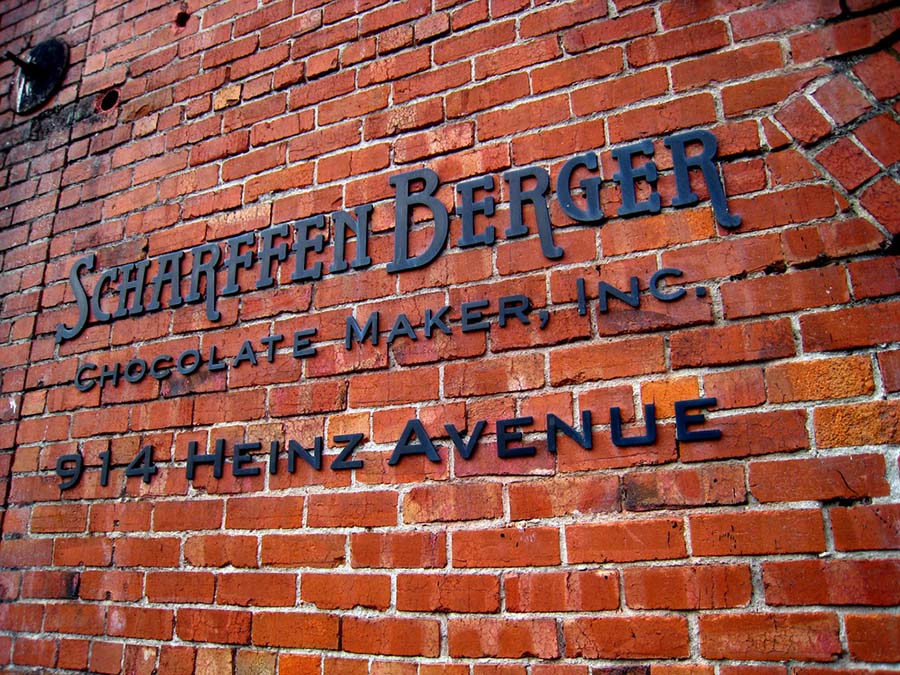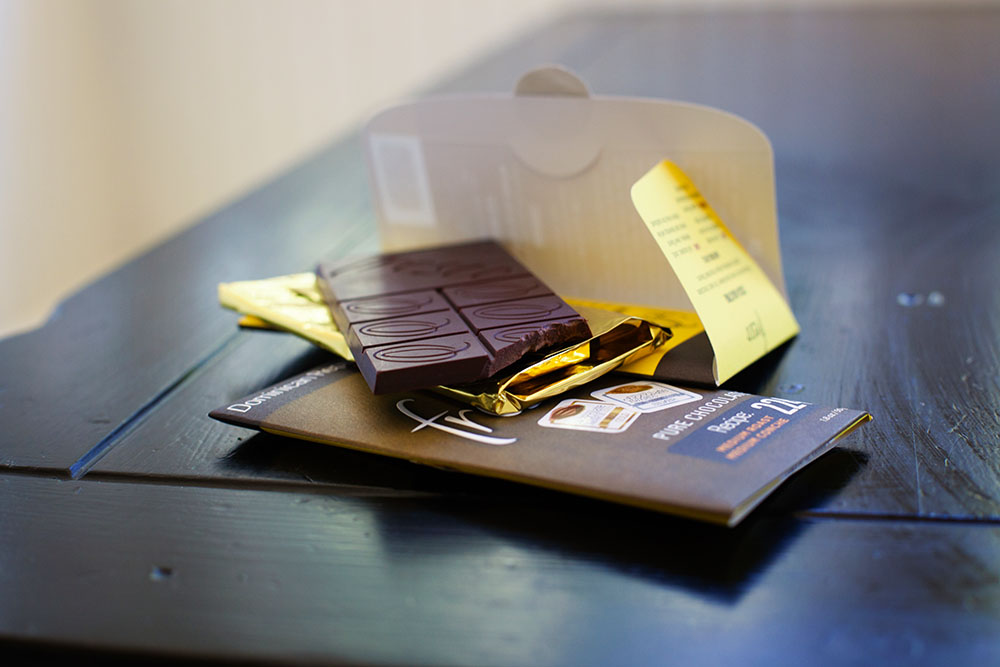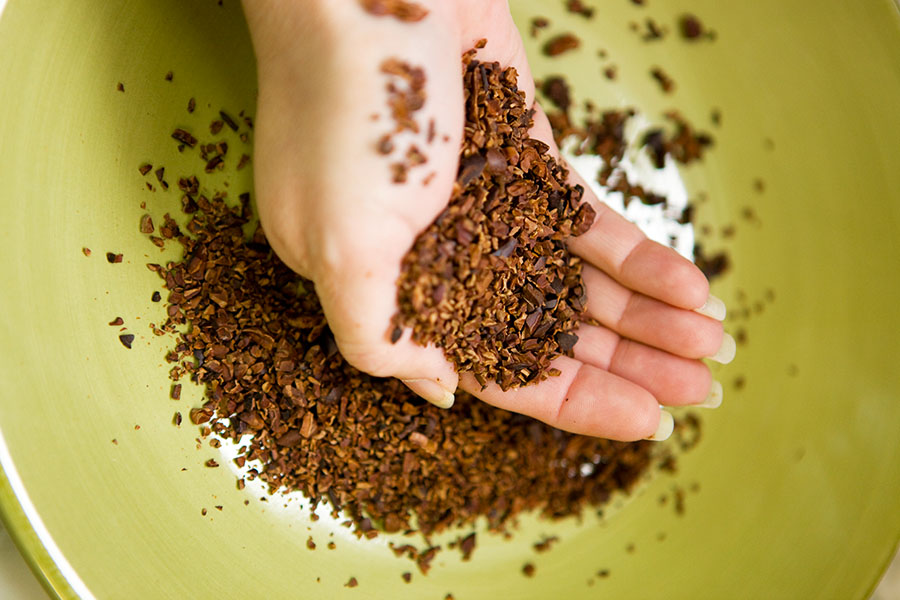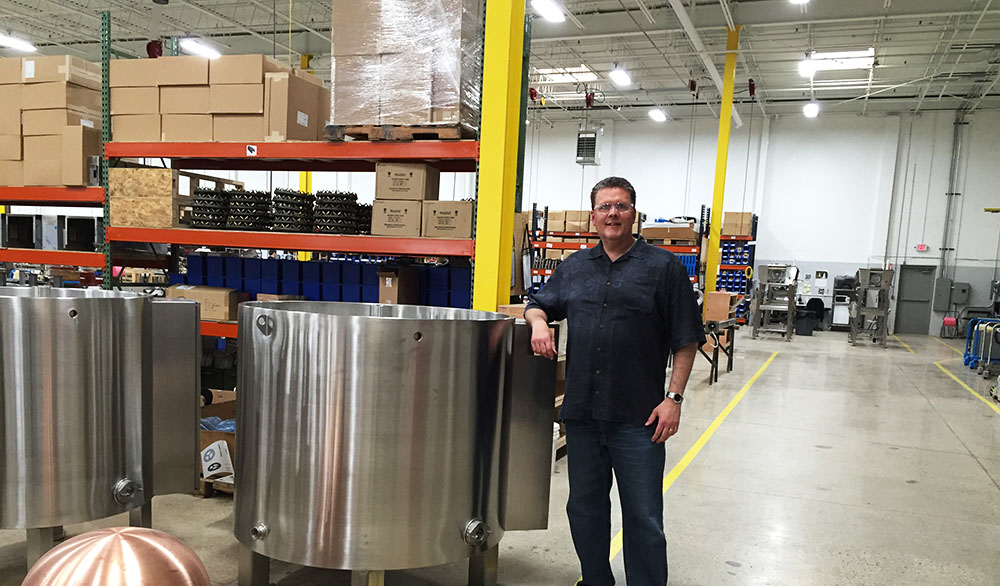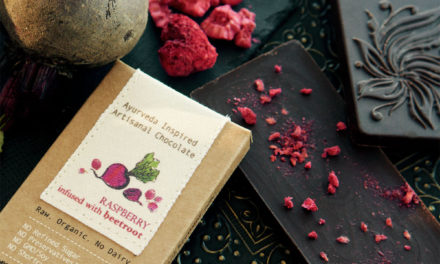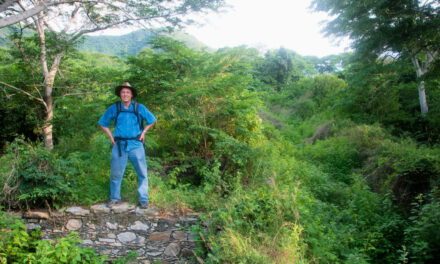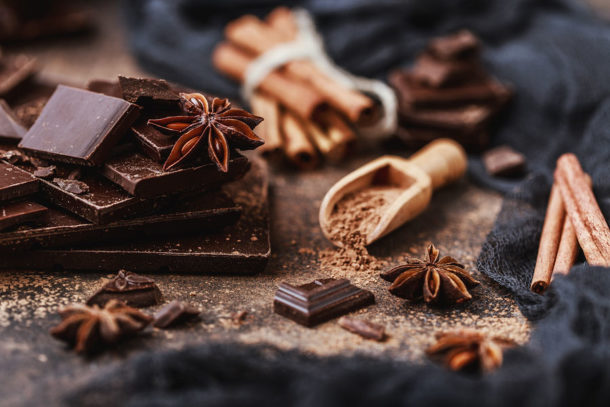“Take calculated risks. That is quite different from being rash.”
— General George Patton
Fresco’s Steady Pace
There’s more than one way to chase down your dreams. Inspirational movies out of Hollywood often focus on the “go big or go home” storyline, where the hero or heroine risks it all for the big payoff. In most cases, however, we find success stems from a series of calculated risks. What we already built in our lives that’s working for us, it remains intact, while we continue to branch out in meaningful ways, pushing forward.
Such is the case for Fresco founder and chocolate maker Rob Anderson —
“My experience may be different from others. We did not go down the romantic entrepreneur road, risking everything to start up a business, working long hours just to break even. Those stories are often inspiring and heartwarming, but our story is more calculated.”
Indeed, by the time Rob and his wife, Amy, decided to turn their chocolate hobby into a chocolate business, their lives were already full of other priorities.
They had four children at home, each involved with school and other activities. College tuition and mortgage payments were of primary concern, much more so than diving into a chocolate business. So Rob and Pam decided to start and grow the business slowly. Self-funding while also remaining debt-free were critical pieces, because they wanted to enjoy the business, not let it weigh them down. Chocolate had to be fun, otherwise, why do it?

Fresco’s booth at the 2016 Northwest Chocolate Festival in Seattle. From left to right: Tabitha (daughter), Rob, Jessica (employee), Amy (spouse and business partner), Amber (daughter), Shu (employee).
Back to the Beginning
Before we go down that road, however, let’s take a few steps back… to the beginning of Rob’s chocolate journey.
Like many chocolate makers, he began on a much different road. After high school, Rob very much wanted a career in abstract topology, also known as astrophysics. He attended the University of California in Irvine, home of the anteaters (yes, the world’s most fearsome mascot), and studied Physics for a few years. At some point, however, he realized the abstract topology road really wasn’t for him, so Rob took some time off from school to work and start a family. Eventually, he returned to finish programs in Electrical Engineering and Computer Science.
“I worked at technology companies for several years as a network design Engineer, during the time when the Internet and worldwide networking was just taking off. It was a blast.”
And then Rob left California in the 1990’s to take a job in Washington State doing similar work. Fast forward a few years, a couple patents, and a stint at Harvard Business School to pick up some leadership skills, and he ended up on a trip, in 2003, back to California.
During that trip, he took a little detour, stopping to tour the Scharffen Berger chocolate factory, in Berkley, CA.
“I’ve always loved chocolate, so when I found myself with some free time, it was an easy choice to sign up for a tour at the chocolate factory.”
A Three Hour Tour
On that particular day they were roasting cocoa beans in a large, antique German ball roaster. Rob says the aroma was incredible. It reminded him of brownies baking in the oven, only better. The tour also included a look inside a large mélange used to crush cocoa nibs into liquid chocolate.
“I could have watched the chocolate swirl around the large granite wheels for hours. On the tour, we tasted roasted cocoa beans and fresh chocolate being processed. The whole thing was intoxicating. Something clicked then, and I knew what I wanted to do when I grew up. “
Endearing way of wording it. After all, isn’t that what we all want, to figure out as grown-ups how to live our best lives?
But even after we grow up, most of us are still kids at heart. In fact, Rob’s dream job, if he wasn’t a chocolate-maker, would be to drive the train at Disneyland. As a child, Rob’s chocolate world revolved around Hershey and Mars products, with no real exposure to fine chocolate… he loved anything chocolate.
“I remember when I was 6 or 7 years of age, adding baking chocolate to everything. Do you know you can mix cocoa powder, powdered sugar and melted butter to make a sauce to pour over anything? None of it tasted very good, but it was brown.”
That’s a love for chocolate alright, or at least chocolate-y concoctions.
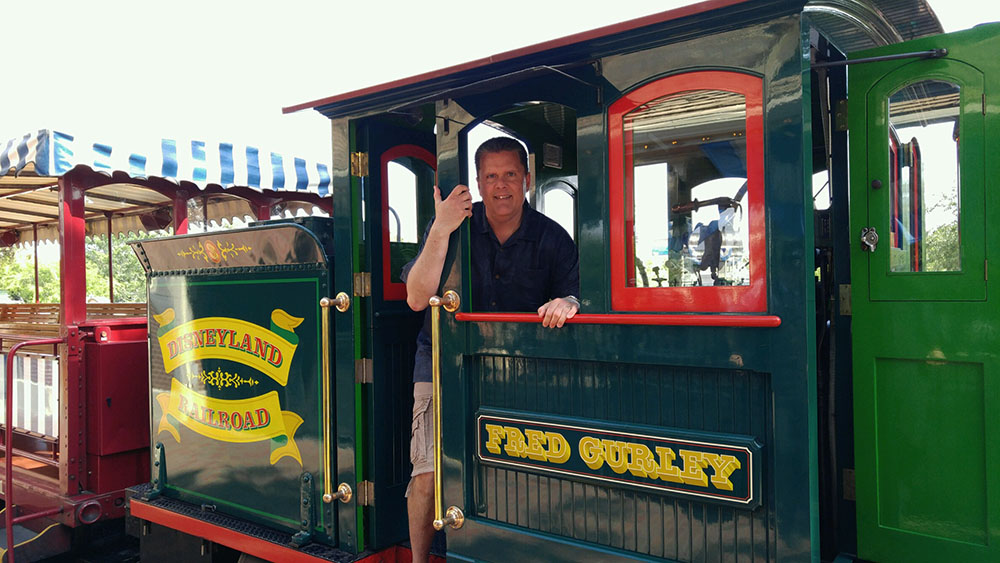
Rob’s other dream job
Chocolatier in the Making
He had no idea then how his child-like chocolate creativity would play out in his adult years, however. The chocolate factory made an impact, and Rob returned several times over the next few years, where he made a few good friends who helped him start down the path to chocolate maker.
“I originally started with the intent of manufacturing a home chocolate making machine. Designing and manufacturing equipment is at the core of my experience.”
Rob envisioned a home kitchen “bread machine” concept. Raw ingredients go in, press the buttons and bread, or in his case chocolate, comes out. As he went down this road, he realized bread machines only make average bread. If you want exceptional bread, go to an artisan bakery.
The same of course applies to chocolate — it’s complex. A machine with pre-configured settings can’t adjust for the nuances required to make an exceptional finished product.
Although the bread concept proved unviable, it’s still in his blood, that desire to explore equipment concepts. So when he began making chocolate, Rob designed and built much of his own chocolate-making equipment, as no lighter-scale equipment existed at the time for small batch manufacturing. Take a look at the machine pictured below — Rob’s self-made cocoa bean winnower.
When there’s an unfulfilled need, Rob many times sets out to fill that gap. See a need, fill a need (cue up Robots, for those who’ve seen the fun, animated feature film.) And his latest experimentation revolves around even better ways to remove shells, assuring chocolate is shell-free.
Lessons in the Craft
Along with creating new equipment, Rob also needed to learn the many nuances involved with chocolate-making. He still remembers the early days… days filled with plenty of mistakes. One early batch of chocolate, made from Jamaican cocoa, had a strange flavor note he couldn’t identify.
“When you make chocolate, there isn’t a lack of eager taste testers standing by. They may all be willing but not all are qualified. My local group of tasters thought the Jamaican chocolate was good, but I knew something was off. Yet, I lacked the experience to pin it down.”
Rob expanded his circle of tasters and contacted a professional chocolate taster who lived in Paris. They corresponded several times, Rob sent her many samples to critique, as her evaluations were both qualified and honest, exactly what he needed.
She told Rob his Jamaican chocolate had an earthly flavor note reminiscent of the aroma of wet grass. Rob agreed, and that’s when it clicked:
His chocolate grinder was noisy, and he didn’t want to disturb people in the house when the machine ran during the night. The grinder sat on a work bench in the garage, a few feet away from his lawn mower. Chocolate absorbs odors… so now it made perfect sense!

Rob’s self-made machine cracks the roasted beans open and separates the husks from the cocoa nibs to make chocolate
“Does anyone besides Hermione Granger like the smell of fresh cut grass? Those who do, probably would have liked that Jamaican batch. The rest of us, not so much.”
Rob believes failures are always predecessors to success. He says it’s important to learn at least one thing from each failed attempt, to prevent wasted effort.
“When I become discouraged, I adapt a quote from Thomas Edison to my situation: I haven’t failed, I have just found 100 ways to not make chocolate.”
Inspiring, and keeping with the brand name as well. Fresco.
“We chose the name Fresco as a play on the word fresh. Fresco is Italian for fresh which could mean fresh taste, fresh ideas or a fresh approach to chocolate making.”
Fresco chocolate is fresh, both in flavor and approach
Complex Simplicity
While creating chocolate, Rob uses his engineering mind set and isolates variables in the chocolate that effect flavor: bean origin and terroir, cacao bean roasting levels and ingredients, and chocolate conche time — all specifics that can dramatically change the flavor of chocolate.
“My philosophy with Fresco is one of minimalism, to use few, exceptional ingredients and try to bring out the unique character of the particular cocoa beans selected for use. The beans we currently work with are certified organic, and thus non-GMO. Most products we make are gluten-free and many are vegan as well.”
Rob will isolate a single parameter, such as cocoa bean roasting level, and offer variations of chocolate based on changes to that parameter. For example, Fresco offers several seemingly identical single origin dark chocolates, save for one key parameter — the cacao bean roast levels. A light roast vs. dark roast results in remarkable flavor differences. Rob enjoys providing these types of unique chocolate tasting experiences. People are always amazed that they can taste the difference when he only alters a single parameter in the chocolate-making process.
The subtleties in Fresco Artisan Chocolate are many
And that process of making chocolate… Rob absolutely loves it.
“It’s a stress reliever. A bad day at work suddenly becomes a wonderful evening inside the chocolate factory. I spend my work-days overcoming business and technical challenges; at night, I just want to make chocolate.”
Over time, this therapeutic, decompression tactic grew into an obsession, then eventually a business. Launched in November 2010, Fresco Chocolate shines in a beautiful part of the United States ––Bellingham, Washington.
“Our business is based on e-commerce and wholesale so we can run it from most anywhere.”
Bellingham is situated on the Puget Sound, with glacier-covered peaks of the nearby Cascade Mountains a short drive away. Basically, Fresco’s base of operations sits between Vancouver, British Columbia and Seattle. Gorgeous.
Sailing Pugent Sound With the Olympic Mountains as the backdrop, photo from Chuck Taylor on Flickr
“We live in the small dairy and raspberry farming community of Lynden, Washington, about a 2-minute commute from our business. The area offers a great blend of culture and lifestyle, and we truly love living here.”
But there’s one downside to this area for anyone working with chocolate. Western Washington is a rain forest. It’s often damp and cool, and of course humidity and chocolate don’t always mix. Rob says they’re constantly fighting to keep chocolate safe from condensation.
His wife, Amy, runs the day-to-day operations, while Rob handles the chocolate making and new recipe development. They have a small staff of good people who help with production. In fact, each of their four children even worked with them at various times since they started in 2010.
“It was a great privilege to spend that additional time with our kids and help them learn the value of work.”
Side Note: Speaking of work, a few years ago Rob transitioned from Engineering into Business Management, and he now works today as a General Manager for part of an international technology company. He continues to show the value of work by managing two jobs as well!
You’ve Got the Look
Fresco doesn’t employ sales people; instead, they generate sales primarily via word of mouth. And Rob designs the packaging for their bars, with the current look actually a fourth generation of packaging.
Their Facebook page cover photo shows all four generations of packaging lined up. The earlier versions looked a bit “engineer-like,” with more details but also more clutter. Always looking to improve, Rob uses feedback from customers to make the packaging more consumer-friendly.
Behind the Brand
Now let’s dig deeper… to the chocolate behind the packaging.
“We only use three ingredients in our chocolate: cocoa beans, cane sugar and cocoa butter.”
Fresco makes only pure, dark chocolate from the bean, using single origin (often single plantation) cocoa beans. They offer several 100% single origin chocolates with only one ingredient: cocoa beans. All of their chocolate is free from nuts, dairy, soy and gluten. All ingredients are organic where possible.
“We sometimes find exceptional flavored cocoa beans from small farms in remote areas that do not have the means to become certified organic. These are sometimes wild crops.”
In these cases, Fresco uses any exceptional beans they find, irrespective of an organic certification. Rob happily pays the farmers a premium to help them continue producing exceptional cocoa.
“Fair trade sounds like a good idea but in many cases the certifying organization receives additional fees that should go to the farmers.”
Fresco uses direct trade; Rob works with a small number of trusted importers who work directly with the farmers and pay premium pricing. There’s complete transparency with the farm gate pricing paid to the farmers, and he highly touts direct trade as the best method for insuring farmers receive fair wages.
Currently, Fresco sources its cacao from five regions: Dominican Republic, Madagascar, Peru, Papua New Guinea, and their most recent region to join the group, the Polochic Valley in central Guatemala. The company also receives solicitations from roughly three to four cacao providers weekly, asking Fresco to try their beans.
“Not all cocoa is good, and It’s fairly expensive to start up a new origin line. We spend a lot of time tasting cocoa beans and tasting other companies’ chocolate. When we find something we really like, we look into bringing that origin in for our line.”
The bars created from Guatemala are 70% bars with light, medium and dark roast levels, and there is a 100% bar with a light roast level.
Methods to the Magic
Fresco believes each bar holds a story, waiting to be told, and each bar’s story contains a few common elements:
RECIPE NUMBER – Every chocolate recipe receives a unique number. Cocoa bean, cocoa percentage, roasting levels, and chocolate conching levels all combine to define a recipe. Also, terroir matters! Cacao is an agricultural crop, subject to season changes. When repeating a chocolate recipe with cocoa from different harvests, the chocolate naturally changes character.
COCOA ORIGIN – The cacao’s country and region speak volumes on how the finished chocolate will taste.
COCOA PERCENTAGE – With all Fresco bars, this is the ratio of cocoa ingredients (cocoa beans and cocoa butter) to sugar.
COCOA ROAST – Roasting is essential to chocolate flavor development. Each cocoa variety has its own unique range of flavors, and different roasting levels can coax these flavors from the cocoa. Fresco’s roast levels include:
light – just enough to soften raw cocoa’s acidic or green edge
medium – cocoa flavors develop to be balanced and flavorful
dark – full bodied, bold, intense, new flavor notes can develop while others may be subdued
CHOCOLATE CONCHE – Heat, motion, aeration and time develop each chocolate’s flavor; this is conching. Changes in time and temperature result in dramatically different chocolate flavors. Fresco’s conche range includes:
none – primitive, natural, pungent, not appropriate for all cocoa, exquisite for some
subtle – softens primitive edge while retaining aggressive flavor notes
medium – balance between aggressive and subdued, mellow
long – flavor peaks and valleys softened to a melodic harmony
Just visit their uniquely Fresco website page, where tables show each cocoa origin they work with. Inside each origin table, recipe numbers show the roast and conche levels for each unique Fresco bar. As the page says, explore the possibilities…
Speaking of possibilities, Fresco offers between ten and thirteen bars for sale on their website at any given time, and right now six of those bars boast distinguished National or International Awards. Four are shown below.
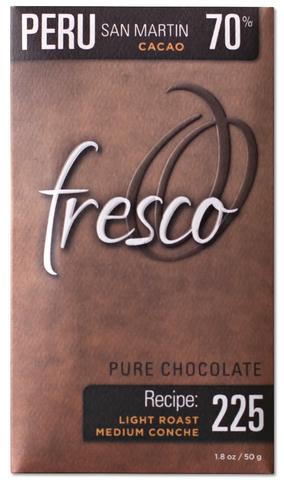

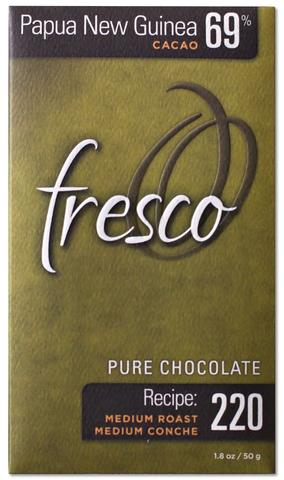

Fresco Chocolate is also available in quite an array of shops, a list of which you can find on their website. Rob prefers to sell his bars in shops with staff who “get it”, who understand the difference between artisan and industrial chocolate.
“You need that customer-facing representation to explain why your chocolate is special. We receive regular inquiries about selling our bars here and there. The ones who get it are easy to separate from the masses.“
Fresco Forward
And future plans for Fresco?
“We’ll continue to grow slowly and methodically, adding retail shops and online customers at a tempered rate (pun intended). My next big challenge is to scale up chocolate production while maintaining the artisan qualities we value. I have some ideas...”
No doubt he does, and we’ll most definitely keep our eyes on this engineer-turned-chocolate-maker to see those ideas come to life.
Stay in touch with Fresco Artisan Chocolate at the links below:
Facebook: https://www.facebook.com/ChocolateFresco
Twitter: https://twitter.com/FrescoChocolat
Instagram: https://www.instagram.com/frescochocolate/
Email: in**@fr*************.com

